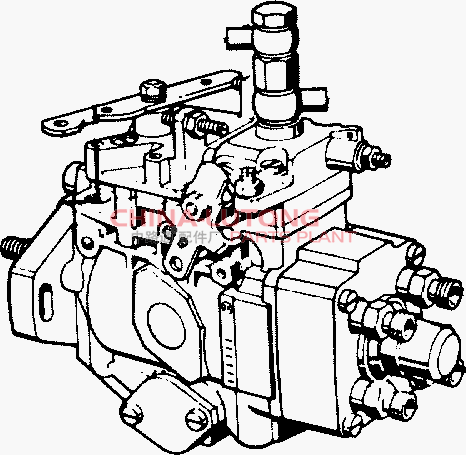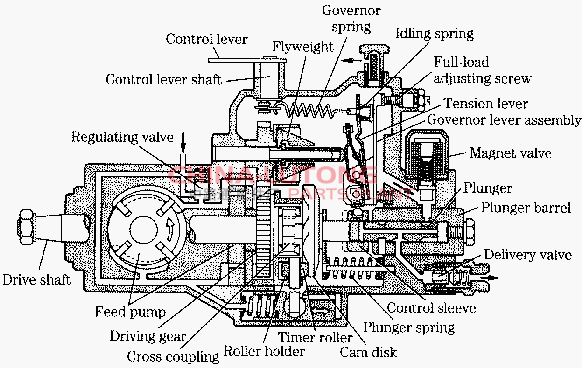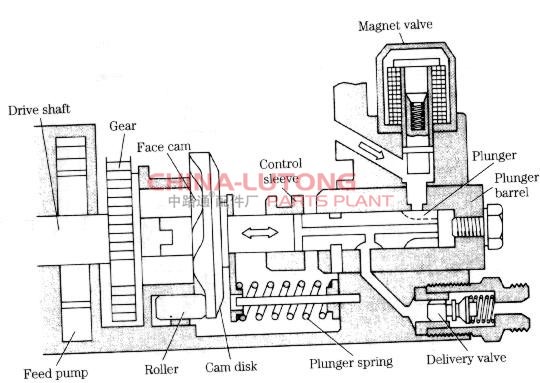For many home mechanics the diesel injection pump is a bit of a mystery. The Bentley and Haynes repair manuals doesn't describe its internals, because it's not serviceable except by a few diesel specialists. Learning some basics of how it works and what its internals are could be of interest to the diesel owner, and the knowledge certainly can't hurt when troubleshooting fuel injection problems, even if one isn't about to take the pump apart.
The purpose of the fuel injection pump is to deliver an exact metered amount of fuel, under high pressure, at the right time to the injector. The injector, unlike in a gasoline engine, injects the fuel directly into the cylinder or a prechamber connected to the cylinder.
The VE in the name of the Bosch pump used in the VW diesels and many other small diesel engines stands for "Verteiler", which is German for distributor or divider. The other common kind of injection pump is the inline pump. The difference between them is that the "Verteiler" VE pump has one fuel metering plunger, and a mechanism (the "Verteiler"/distributor) to send the fuel to the right cylider. The inline pump has one plunger for each cylinder.

The Bosch VE has comparatively few moving parts, but what does move does so in a complex way. The figure to the left is from a Yanmar pump, which works and looks the same as the Bosch . On the leftmost end in the picture is the fuel feed pump. This is a vane pump, just like the vacuum pump on the VW diesel engine. Its purpose is to suck fuel from the tank and deliver it to the metering pump. All the things shown on the right in the figure have to do with the metering, timing and distribution of fuel delivery. The figure below shows this part in detail.
The plunger (right middle in the figure) in the VE pump both rotates along its axis and performs a reciprocating translation in and out. It is the translation that performs the high pressure pumping, while the rotation is responsible for metering and sending the fuel to the correct cylinder. 
The cam disk is rigidly attached to the plunger. The drive shaft rotates the cam disk. The cam disk rides on four rollers (only one shown in this picture), and has four lobes. Thus for each revolution the plunger will pump four times. Note that with this arrangement the plunger stroke is constant. The metering (regulation of how much fuel is delivered) is done not by changing the mechanical stroke, but by spilling some of the fuel through spill ports, and thus changing the effective stroke . This is done by uncovering a spill port under the control sleeve at a particular angle of rotation. The other purpose of the rotation is to deliver the fuel to the correct cylinder. This is done by having four four delivery valves (only one shown in the figure), one for every 90 degrees of rotation. During a full revolution the plunger makes four strokes, one at 0, 90, 180 and 270 degrees. During each stroke the delivery port in the middle of the plunger is connected to a particular delivery valve.
To understand the function in some detail lets consider one stroke. During the backward motion of the plunger, the rotation uncovers a fill port (to the right in the figure, just below the magnet valve (solenoid)), and the plunger barrel is loaded with fuel. At bottom dead center the fill port is closed. On the forward pressure stroke fuel is pressurized (to over 120 bar). At this time the Plunger barrel is connected to a particular delivery valve through the channel in the center of the plunger, and a port in the side. When pressure builds up to the delivery valve opening pressure, the valve will open and deliver high pressure fuel to the injector.
When the desired amount of fuel has been injected the spill port opens (located under the control sleeve in the figure), and the pressure quickly drops. This causes the delivery valve to close. During the rest of the stroke fuel is "spilled" through the spill port instead of being injected into the cylinder.
The position of the control sleeve controls at what angle the spill port opens, and thus determines the amount of fuel injected, in other words it controls the metering. The control sleeve is moved in response to a combination of accelerator position and engine speed. The latter is determined by a mechanical governor.
Other functions
Some other functions of the fuel injection pump are:
- Timing The timing is adjusted in response to engine RPM. At higher RPM s, the fuel pressure from the vane transfer pump is higher. Pressure changes effects a spring loaded plunger, and the resulting movement will move the cam rollers to either advance or retard the timing. There is also a cold start device which advances the idle timing manually.
- Governor A mechanical governor limits the maximum speed of the engine to 4800 rpm in the bus/vanagon application and 5350 rpm in newer passenger cars. It can be seen just above the cam disk in the middle figure.
- Stop A magnet valve or solenoid (shown in the figures) opens and shuts off the fuel channel between the feed pump and the metering pump.
- Aneroid An air inlet pressure sensor is used to determine maximum amount of fuel delivered on injection pumps for turbo engines. On newer ('89 and later) naturally aspirated engines a similar arrangement is used for altitude compensation.
|



